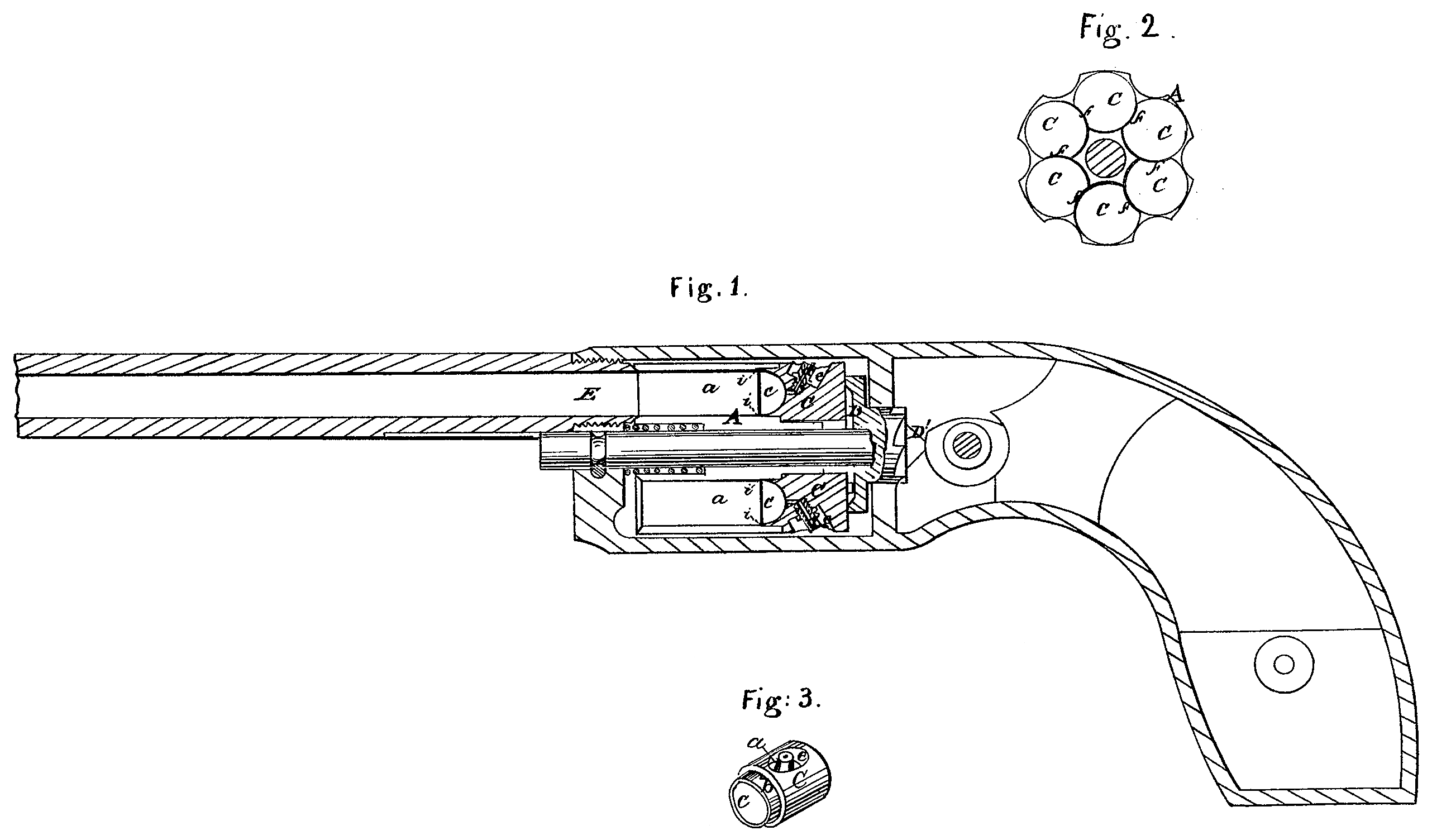US 33770
UNITED STATES PATENT OFFICE.
CHARLES H. ALSOP, OF MIDDLETOWN, CONNECTICUT.
IMPROVEMENT IN REVOLVING FIRE-ARMS.
Specification forming part of Letters Patent No. 33,770, dated November 26, 1861.
To all whom it may concern:
Be it known that I, Charles H. Alsop, of Middletown, in the county of Middlesex and State of Connecticut, have invented certain new and useful Improvements in Fire-Arms; and I do hereby declare that the following is a full, clear, and exact description of the same, reference being had to the accompanying drawings, forming part of this specification, in which—
Figure 1 is a central longitudinal section of a pistol with my improvement; Fig. 2, a back view of the rotating chambered cylinder, and Fig. 3 a perspective view of the breech-pin.
Similar letters of reference indicate corresponding parts in the several figures.
This invention is more especially applicable to revolvers, but is also, to some extent, applicable to single-shot breech-loading fire-arms.
It consists in a peculiar construction of and mode of applying a movable breech-pin, and in the peculiar construction of the chamber for the reception of the movable breech-pin.
To enable others skilled in the art to make and use my invention, I will proceed to describe its construction and operation.
The drawings represent the application of my invention to a revolver.
A is the cylinder, and a a are the chambers, bored right through it and counterbored slightly larger for a short distance in from the rear, as shown in Fig. 1, and each fitted with a separate breech-pin, C. The front portions, b, Fig. 3, of the exteriors of the breech-pins are turned smaller than the portions in rear of it, to fit snugly but easily into the counterbored rear portions of their respective chambers; and the frontends of the said pins have cup-shaped cavities c c, Fig. 1, formed in them, the sides of the said cavities being left very thin, that they may be acted upon by the explosion of the charge in such manner as to be expanded against the interiors of the counter-bores of the chambers, and thereby to make the joints between the chambers and the breech-pins so tight as to prevent the escape of gas or smoke at the rear end of the cylinder. In the portions of the breech-pins which project from the rears of the chambers there are formed cavities e e, for the reception of the cones or nipples d d, said cavities being of such depth that the cones do not project beyond the exterior surfaces of the pins. It will thus be seen that each breech-pin constitutes also a cone-seat and a gas-check. The rear ends of the breech-pins fit against the recoil-shield D, which confines them in their places. When the cylinder is taken out of the arm the breech-pins can be drawn out from the chambers without difficulty.
The distance to which the chambers a a are counterbored is slightly greater than the length of the front parts, b, of the breech-pins, which are fitted to the counter-bores, in order that the slight shoulders i, Fig. 1, formed in the chambers in front of the counter-bores may be exposed to the pressure of the gases evolved from the powder when the piece is fired, and that by such pressure on the said shoulders the cylinder or chambered breech may be driven forward against the fixed barrel E, and be caused to make a tight joint therewith, while the breech-pin is pressed backward against the recoil-shield by the pressure of the gases against its front end. By the last-mentioned action of the breech-pin the wear of the recoil pin D’ is compensated for, and by the pressure on the shoulders i the recoil is in a great degree counteracted.
The invention, as far as I have yet described it, is applicable to all kinds of breech-loading fire-arms in which one or more movable chambers are used, as well as to revolvers. Fig. 2 exhibits a feature which is only applicable to revolvers and other many-chambered fire-arms. This feature consists in cutting a concave recess, f, in that portion of each breech-pin which projects in rear of the cylinder or many-chambered breech, to fit the periphery of the adjacent breech-pin on one side of it, by which means the several breech-pins are locked together in a very effective manner to prevent them from turning.
Having now described my invention, I will proceed to state what I claim as new and desire to secure by Letters Patent:
1. In combination with a breech-pin applied as herein described, the shoulder i, so formed in the chamber by counterboring that the force of the explosion acting upon it will tend to press forward the cylinder or chambered breech into contact with the barrel, while the force acting against the breech-pin will tend to press it back against the recoil-shield or its equivalent, substantially as herein described.
2. In a revolver or many-chambered fire-arm, forming recesses f f in the sides of the breech-pins, to fit to the peripheries of the adjacent ones, substantially as and for the purpose herein specified.
CHARLES H. ALSOP.
Witnesses:
W. B. Holly,
Jonathan Barnes.

